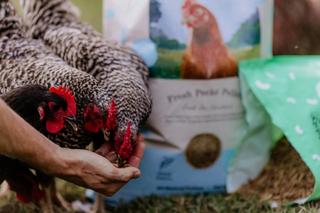How Hens Create a Rainbow Basket


When you open a farm-fresh egg carton and find hues ranging from robin’s egg blue to olive green, speckled brown and even creamy pink, it’s hard not to smile.
Colored eggs have become a symbol of backyard chicken keeping and breed diversity, a small but powerful reminder that nature rarely sticks to just one shade. But where do these colors come from, and what do they tell us about the hens that lay them?
Let’s dive into the fascinating realm of colored eggs — from the biology behind shell pigmentation to the breeds known for their beautiful eggs — and how you can curate your own rainbow basket.
The Science Behind the Shell
Contrary to popular belief, all eggs start white. That’s right — regardless of the final shell color, the base structure of every egg is white calcium carbonate. Pigmentation happens at the very end of the egg formation process, in the hen’s shell gland, during the last few hours before laying.
Two main pigments are responsible for most colored eggs:
Oocyanin: This pigment is responsible for blue eggs and is deposited throughout the entire shell thickness. That means a blue egg is blue both inside and out. Oocyanin is a bile byproduct.
Protoporphyrin: A pigment derived from hemoglobin, it is deposited only on the outer surface of the shell and gives shades of brown, chocolate, tan and speckled hues.
Green and olive-colored eggs come from a combination of both pigments — blue pigment throughout the shell, overlaid with brown on the surface. Speckles are often excess calcium or pigment irregularly deposited. The bloom (cuticle) layer can hold much of the brown pigment, affecting interior color on some green eggs.
The shell color does not affect the flavor or nutrition of the egg, but it does serve as a visual hallmark of genetic diversity and a hen’s lineage.
Factors Influencing Eggshell Color
While genetics is the primary determinant of egg color, a few other factors can subtly influence the final hue:
- Age of the Hen: Many hens lay darker eggs early in their laying cycle, which gradually lighten as they age and as the season progresses.
- Stress: Heat, cold, flock dynamics and predator pressure can interrupt pigment deposition.
- Diet: Though pigment isn’t formed from food colorants, a poor diet can affect the hen’s overall health and ability to produce consistently pigmented eggs.
- Lighting and Season: Some hens will lay deeper-colored eggs in cooler months due to changes in photoperiod and metabolic activity.
Despite these influences, shell color will always stay within the genetic range of the individual bird.
Breeds and Their Beautiful Eggs
If you’re dreaming of a rainbow basket, you’ll need to choose your breeds wisely. Here’s a look at some common and rare breeds known for their egg colors:
Blue Egg Layers
Ameraucana: These American birds lay medium blue eggs and have distinct muffs and beards. They’re often confused with Easter Eggers but are a recognized breed with a standard.
Araucana: Originating in South America, these rumpless chickens also lay true blue eggs and are prized for their unique appearance.
Cream Legbar: A British breed with auto-sexing traits — meaning males and females can be distinguished at hatching by their down color or patterns — Cream Legbars lay light blue eggs and are excellent for backyard keepers.
Green and Olive Egg Layers
Olive Egger: A hybrid between a blue-egg layer and a dark brown-egg layer (often Ameraucana × Marans), Olive Eggers produce a range of olive-green shades, sometimes even speckled.
Easter Egger: These hybrids are not a breed but rather a mixed lineage often carrying the blue egg gene. They can lay blue, green or even pinkish eggs.
Dark Brown Egg Layers
Marans: Marans (especially Black Copper Marans) are famous for their deep, chocolate-brown eggs, often with a glossy sheen.
Welsummer: These Dutch birds lay rich, terra-cotta eggs, frequently with speckles.
Barnevelder: Another beautiful breed with deep brown egg production and striking laced plumage.
Light Brown and Tinted Egg Layers
Buff Orpington: These gentle giants lay large, light brown to peach-toned eggs.
Rhode Island Red: A classic American dual-purpose breed, they produce dependable medium-brown eggs.
White Egg Layers
Leghorn: Famous for their prolific laying and snow-white eggs, Leghorns are commercial egg producers but still found on many homesteads.
Ancona: This Mediterranean breed lays bright white eggs and is known for its foraging ability.
Creating Your Rainbow Basket
Creating a colorful egg basket isn’t just about the aesthetic appeal — it’s also an opportunity to maintain rare breeds, diversify your flock’s genetics and explore the unique traits each breed offers. Here are a few tips to get started:
Plan Your Palette: Think about the colors you want — blue, green, brown, speckled, white — and then research the breeds that produce them.
Diversify for Stability: Having multiple breeds can provide consistent egg production throughout the year, as different breeds respond to weather, light and feed conditions differently.
Choose for Personality and Purpose: Egg color is just one trait. Also consider size, temperament, cold/heat hardiness, broodiness and predator awareness.
Keep Records: If you hatch your own chicks, especially from mixed-breed flocks, keep notes on which hen laid which egg color. This is especially useful if you’re developing your own olive or rainbow egg lines.
The Value of Color
Aside from their natural beauty, colored eggs offer surprising value, especially for small farms and homesteaders. Consumers are often willing to pay more for mixed-color dozens due to their visual appeal and perceived freshness. Many market growers have turned to heirloom or specialty egg baskets to differentiate themselves and tell the story of their flock.
In addition, many of the breeds that produce colored eggs are heritage or rare breeds, meaning by keeping them, you’re also participating in conservation efforts. Organizations like The Livestock Conservancy encourage the preservation of heritage breeds, and your backyard flock can be part of that mission
The next time you open an egg carton filled with pastel blues, mossy greens, deep browns or pristine whites, remember that each egg reflects genetics, biology and history. Colored eggs don’t just brighten breakfast — they celebrate the diversity of poultry and the joys of small-scale farming.
Whether you’re a seasoned chicken keeper or a curious newcomer, embracing a colorful egg basket is an invitation to explore breeds, genetics, sustainability and the natural wonder of the humble egg.
Tags:Chicken Scratch

Chicken Whisperer is part of the Catalyst Communications Network publication family.












